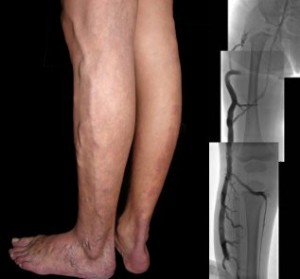This syndrome was described by 2 French neurologists, Maurice Klippel and Paul Trénaunay in 1900. The leg is the commonest part affected. From a management perspective, if patients complain of pain or discomfort it is important to discriminate whether the cause is from the altered biomechanics of limb asymmetry, pressure on surrounding nerves or from chronic venous insufficiency. The latter may result in varicose veins, oedema, lipodermatosclerosis, bleeding and ulceration. There is an increased risk of deep and superficial vein thrombosis in KTS as well as bleeding from unrealised visceral venous malformations. The strategy of treating venous insufficiency is to abolish the areas of reflux without compromising the venous return. Graduated elastic compression stockings help to relieve the oedema and/or lymphoedema. The arterial system is not usually affected.
BB LEE Klippel-Trénaunay syndrome is a clinical condition that presents with vascular and non-vascular malformations together. It is named after two clinicians who first described the syndrome as comprising of a port wine stain, atypical varicose veins and enlargement of a limb. The major vascular malformation components are a venous malformation (VM) and a lymphatic malformation (LM). These are present in various combinations which can be extra-truncular and truncular. Thus there are 4 different VM and LM lesions to be taken into consideration. This makes the clinical condition very complex for management. The ‘marginal vein’ is the most common truncular VM lesion. It accompanies the most serious complication and morbidity, which is a high risk of venous thromboembolism as well as chronic venous insufficiency. This is due to severe reflux caused by congenitally absent valves. The ‘marginal vein’ is an embryonic tissue remnant which failed to regress normally during development. It is often accompanied by iliac/femoral vein aplasia or hypoplasia. Therefore, a careful evaluation is warranted to assess its role as a hemodynamically critical compensatory route for venous drainage before excision is contemplated.
